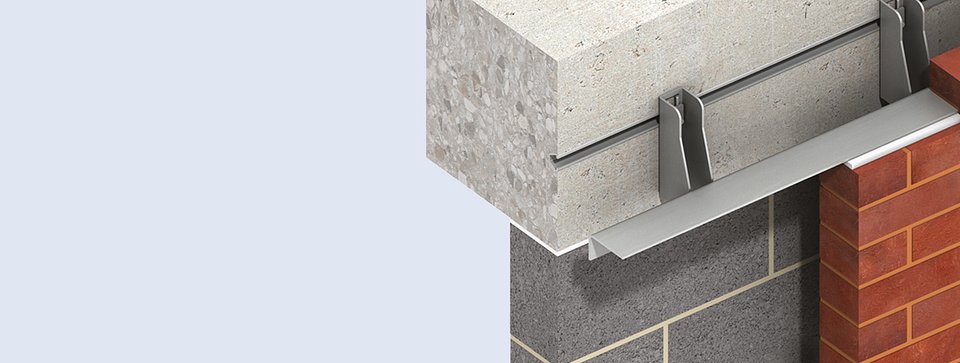
Masonry Support
Design Considerations
The maximum size of a masonry panel should be restricted to limit the effects of differential movement. This is particularly important if clay brickwork is used with concrete blockwork and a concrete frame. To allow for a vertical movement of around 1mm per metre, in buildings exceeding four storeys or 12 metres in height, movement joints are generally positioned at every storey or every second storey.
Support Detail
Horizontal Movement Joints
The support will be positioned directly over the horizontal movement joint. The joint will often incorporate a compressible filler and should be of sufficient size to allow for expansion of the masonry below and any shrinkage or deflection of the structural frame. The underside of the support system should be positioned around 2mm above the joint to allow for the support leg to settle when supporting the brickwork above.
The clear joint below should be at least 10mm where there is a single storey height of brickwork below the support system. Where there are two storeys or more of brickwork below the support system, the clear joint should be sufficient to accommodate all expected movements. This may result in clear joints in excess of 10mm. Damp-proofing is normally located at the support position. Wall ties should be incorporated within 300mm above and below the support.

Tolerances
It is important to select the correct support system to ensure that building tolerances can be accommodated. Adjustment will be required in all three planes. Ancon brackets have a slot at the back to provide vertical adjustment. A serrated surface prevents any slip. Longitudinal adjustment is provided by an Ancon cast-in channel in concrete structures, or horizontally slotted holes in steel framed structures.
The AnconOptima System features a fixing zone providing a total of 50mm horizontal adjustment allowing the system to be fixed to pre-drilled holes rather than slots in steelwork and eliminates clashes with reinforcing bars in concrete. Subject to the type of fixing used, AnconOptima brackets can be changed on site to suit variations in the structural edge beam. Other systems accommodate such variations by adding shims between the system and the structure, or by increasing the bearing of the brickwork. The maximum thickness of shims should not exceed the outside diameter of the fixing or 16mm, whichever is less.
Corrosion Resistance
Ancon Support Systems are manufactured from grade 1.4301 (304) stainless steel and will be suitable for most building applications. In particularly corrosive environments, or where part of the support will be visible, grade 1.4401 (316) should be considered. These are both Austenitic grades of stainless steel which have a thermal conductivity of 17W/mK.
Bi-metallic Corrosion
Bi-metallic corrosion may occur in a damp environment where the stainless steel support system is bolted to the structural steel frame. This will not affect the stainless steel, but could slightly increase the corrosion rate of the carbon steel. This can be prevented by excluding moisture from the detail, or by isolating the two dissimilar metals. Isolation Patches and Thermal Breaks are also available for use with Ancon Support Systems.
Thermal Breaks
Ancon masonry support systems can be supplied with thermal breaks which are positioned between the structural frame and each support bracket. These thermal breaks have a thermal conductivity of just 0.3W/mK and minimise the cold bridging effect of the structural stainless steel support angle penetrating the insulated building envelope. For more information, download the brochure or contact us.
Ancon Thermal Breaks (PDF, 2.88 MB)
Fixing Methods
There are various methods of fixing Ancon Support Systems to both concrete and steel structures. Visit the Channel and Bolt fixings section for more information.
Latest News
Leviat Launches New 300mm Type 4 Wall Tie for Wider Cavities
Leading construction accessories manufacturer, Leviat, announces the release of its new Ancon Staifix HRT4 300mm Wall Tie designed for use in wider walls with cavities ranging from 151-175mm. The addition of this product to the existing range will help specifiers and builders to meet the latest Part L regulations and achieve the more stringent U-values and building fabric requirements in the upcoming Future Homes Standard.
Enhanced Ancon IHR Head Restraints Now Accommodate 100mm Gaps Due to Customer Demand
Due to customer demand and changes to fire regulations, Leviat have successfully re-engineered the Ancon IHR range of internal head restraints, now accommodating gaps at the wall head of up to 100mm, extending the previous maximum of 75mm.
